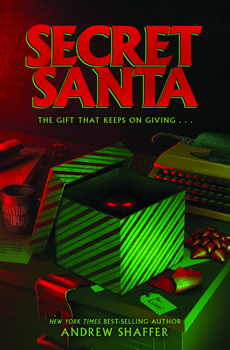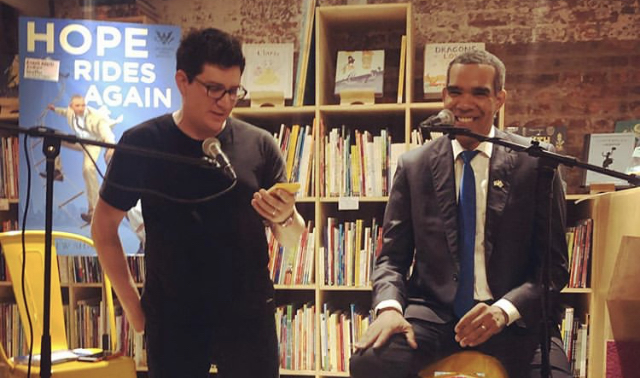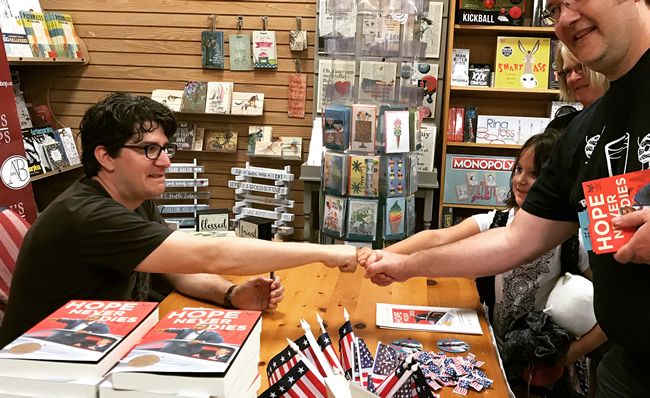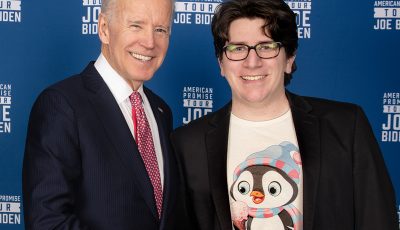

Up Close: Andrew Shaffer
Balancing Horror and Comedy
Any horror fan worth her salt can recommend a dozen Christmas-themed fright flicks that aren’t Silent Night, Deadly Night—but filling your TBR pile with (good) holiday horror is a little more challenging.
Thank Krampus, then, for a seasonal offering from Quirk Books, one of the most consistently reliable sources of quality horror lit. The Philadelphia-based publisher already scored a 2020 horror hit with Grady Hendrix’s The Southern Book Club’s Guide to Slaying Vampires, and they’re looking to follow it up with Andrew Shaffer’s SECRET SANTA, a yuletide horror-comedy that reads like a literary cousin of Gremlins: a pitch-perfect mashup of ’80s-inspired supernatural horror spiked with liberal doses of black humor, with snark to spare.
Billed as The Office meets Stephen King, SECRET SANTA is set against the backdrop of the 1980s horror publishing boom that filled drugstore spinner racks with a seemingly endless stream of lurid genre paperbacks (a subject that was explored brilliantly in Hendrix’s Paperbacks from Hell, also from Quirk). The plot centers on Lussi Meyer, a young editor who makes a devil’s bargain with the owner of a prestigious New York publisher: Lussi, who’s just been laid off from her position with another house, will save the failing Blackwood-Patterson from insolvency by finding and publishing the next Stephen King, in exchange for a full-time senior editor position. But before Lussi can tackle the (literally) killer slush pile lurking in Blackwood-Patterson’s basement, she has to deal with hostile co-workers, cryptic warnings about the building’s gruesome history, and an office gift exchange that leaves her in possession of a possibly-murderous doll with ties to a gruesome European Christmas legend.
A New York Times bestselling author and alumnus of the prestigious Iowa Writers’ Workshop, Shaffer (pronounced SHAY-fer) is best known for satires and parodies such as the Obama Biden Mysteries (Hope Never Dies; Hope Rides Again) and Fifty Shames of Earl Grey. He’s also the author of How to Survive a Sharknado and the 2016 Ghostbusters reboot tie-in Ghosts from Our Past. He co-owns 8th Circle Press with his wife, novelist Tiffany Reisz, and runs a cheerfully subversive greeting card company called Order of St. Nick.
In his first-ever interview with The Big Thrill, Shaffer talks about taking SECRET SANTA from an editor’s suggestion to a full-length novel, offers some insight on balancing comedy and horror, and weighs in on whether it’s a good idea or a bad one to read a horror novel in 2020.
In the acknowledgments, you mention that Quirk’s editorial director, Jhanteigh Kupihea, suggested a horror novel based on a Secret Santa gift exchange. What appealed to you about that idea?
The first novels I attempted to write—we’re talking fourth or fifth grade here—were horror novels. Stephen King rip-offs, like Revenge of the Vicious Animals (based on Cujo). Over the years, I continued to write horror, including my first published short stories in my twenties.
The direction my writing career has taken has been heavily influenced by the industry, however: I write full-time, and there wasn’t enough money in horror to pay the bills. Horror was out of vogue for much of the past two decades. Lately, though, it’s been on the upswing—there’s a horror section in Barnes & Noble, Books-A-Million. When Jhanteigh asked my thoughts on a holiday horror novel, I jumped on it. One of my favorite stories of all time is A Christmas Carol. I’m not saying my book is Dickensian, but it’s very much in the tradition of the Victorian Christmas ghost story.
How did you go from Jhanteigh’s suggestion to a fleshed-out story?
My first pitch was for a White Elephant exchange, and not a Secret Santa exchange. Then, last year, someone published a thriller called White Elephant that hit some of the beats in my synopsis. While I still could have gone in that direction—and while this isn’t the only book titled SECRET SANTA—I went back to the drawing board. And I’m glad I did, because the final book went in some fun directions I never expected. That happens with every novel, though. If I knew where it was headed, exactly, I would get bored writing it. And you can always sense when a writer is bored with their own book.
Which came first: the decision to center the novel on a female protagonist, or to base it on the legend of Frau Perchta, the “Christmas Witch”?
This may sound counterintuitive when you look at my published work, but, believe it or not, I always start with character. Everything about SECRET SANTA besides the gift exchange itself—right down to the setting in an ’80s publishing house—flowed from the character. Her experience as a horror editor inside a literary publisher is partly based on my own time as a genre writer in undergrad writing workshops at the University of Iowa. The further I dug into the protagonist’s past, the clearer the plot—and what she was up against—became.
Were you familiar with Frau Perchta and the Perchten before writing SECRET SANTA?
Only in the vaguest sense. The look of the modern American Krampus is heavily influenced by the costumes worn in Austria and Germany’s traditional Perchtenlauf. These “Perchten parades” were once done to ward off evil winter spirits. Now, they’re more performative than ceremonial. The tradition varies wildly by country, region, and village, though, and that gave me plenty of leeway to utilize the Perchten in a way that fit the story, and not the other way around.
Frau Perchta, by the way, isn’t a focal point of the book, but she’s a fascinating character. Her nickname is the “Christmas Witch.” She visits naughty children, slits their bellies open, and stuffs them with hay. On a possibly related note, surveys have found that German children are very well behaved.
You thank fellow Quirk authors Clay McLeod Chapman and Grady Hendrix in the acknowledgments, and there are threads connecting SECRET SANTA to Clay’s The Remaking (a reference to that novel’s fictional horror film, Don’t Tread on Jessica’s Grave) and Paperbacks from Hell (the backdrop of the ’80s horror publishing boom). What kind of feedback, if any, did they offer on early drafts?
The book went through so many drafts and changes, I’m honestly not sure. Clay pointed out some plot holes in an early draft; Grady provided moral (or is it immoral?) support for this fledgling horror writer. My wife, romance and gothic writer Tiffany Reisz, had a hand in shaping the protagonist—I’ve written female leads before, but it took a while to get Lussi just right. And, of course, my editor had a huge impact on the final book. It takes a village, as they say.
SECRET SANTA is a fun, nostalgic read for horror fans like me, who grew up during the ’80s paperback boom. Assuming you’re one of us, what are some of your fondest memories of that period?
We had a used bookstore in Cedar Rapids, where I used to buy and trade genre novels (horror, mystery, science fiction). My grandma and I would pass them back and forth as well—Stephen King, John Saul…the list goes on. A hundred names I couldn’t recall, which was why it was such a trip to read Grady’s book and put names to the books I remember reading.
The used bookstore is still there, and in the same location—unfortunately, I’ve become allergic to musty old paperbacks, so it’s mostly e-books for me these days. Which is fine, since Valancourt Books is putting out so many of those old “classics.”
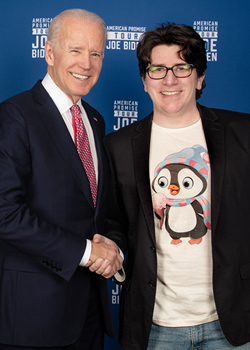
Shaffer meets future President-elect Joe Biden in December 2017, seven months before Shaffer’s first Obama Biden Mystery, Hope Never Dies, hit bookstores.
I love that Quirk has become an incubator for great horror. Do you get the sense that the folks there genuinely like and appreciate the genre?
Quirk has been doing their own thing in the horror-sphere for years. They’ve had great success with Grady Hendrix, Miss Peregrine’s Home for Peculiar Children, Pride and Prejudice and Zombies…the list goes on. It’s the polar opposite of the dusty old literary publishing house in SECRET SANTA. In fact, the idea for a haunted gift exchange actually comes from Quirk’s own annual holiday party. So, yeah, there are some horror buffs in the building.
Casting a broader net, how do you think horror is viewed by the larger publishing world right now? Great horror is always out there, but attitudes about it seem to shift quite a lot…
When we talk about a “horror revival,” it doesn’t necessarily mean that horror writers were dormant. Great horror is always being written, but it’s not always being published by top-tier publishers or being given space in bookstores. In some ways, horror does change shape with the times, though: Twilight was paranormal romance, and ushered in a huge influx of young adult vampire and werewolf novels. Were they “horror?” Depends on your interpretation. We’re definitely seeing more adult horror make a cultural impact lately, thanks in part to movies based on books like World War Z and Bird Box.
Horror-comedies are notoriously tough to pull off—the most common complaint is that they end up being neither particularly funny nor scary. You manage both with SECRET SANTA. How did you approach that balancing act?
The trick is to always take the horror seriously. As soon as your characters start mocking the villain—or the villain starts cracking wise—you’ve lost the reader. If the threat isn’t “real” to the protagonist, then what’s the point of the book? Horror is about confronting our fears, not laughing at them. The comedy is there to break the tension…so that you, the writer, can ratchet it back up when they’re not looking.
I’m curious about your work on movie tie-ins like Ghosts from Our Past and How to Survive a Sharknado. How did you become that guy?
It’s a complete accident. My agent asked if I was a fan of Sharknado, and I said no, but for the right price I could be. Syfy wanted a survival guide to Sharknado and their entire slate of B-movies (Sharktopus, Stonados, etc.). Because of my background writing parodies and non-fiction, the editor thought I might be right to tackle the project. I still think the first Sharknado is genius—the actors play it completely straight. That’s what I tried to do with those tie-in books.
I guess I’m in the minority here, but I loved Paul Feig’s Ghostbusters. I think he and Katie Dippold are two of the best comedy screenwriters working now. What was it like working with them on Ghosts from Our Past?
I’d been a fan of Paul Feig’s from his days directing Freaks and Geeks, so it was really a dream collaboration. Since the 2016 Ghostbusters movie was a reboot and not a continuation of the original films, I had a lot of free rein when it came to the content of Ghosts from Our Past. Paul and Katie sent notes on my material, and Paul—and Dan Aykroyd—had final approval. Which was stressful, not going to lie! It was a funny movie on its own merits, but it’s impossible to watch Bill Murray and not think about Peter Venkman.
Sorry for being so on-the-nose here, but is 2020 the best year or the worst year to read a horror novel?
It’s the worst year to read a pandemic-themed horror novel, in my opinion. Paul Tremblay’s Survivor Song was so timely that I couldn’t get into it—it wasn’t the writing, it was the subject matter. Sometimes you can be too on the nose!
In general, it’s a great year to read horror, though. The most effective horror novels are successful because they’re a safe space for confronting our fears. Dracula really wasn’t about a bloodsucking vampire, or the eternal struggle between good and evil; it was about venereal diseases. Stepford Wives wasn’t about robots; it was about feminism and male fragility. Horror seems to spike in popularity during times of upheaval and high cultural anxiety. That’s good news for horror writers and readers…and bad news for everyone else.
- Between the Lines: Rita Mae Brown - March 31, 2023
- Between the Lines: Stephen Graham Jones - January 31, 2023
- Between the Lines: Grady Hendrix - December 30, 2022

